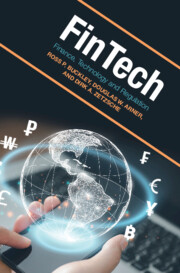Book contents
- FinTech
- FinTech
- Copyright page
- Contents
- Figures
- Acknowledgements
- Abbreviations and Technical Terms
- 1 Introduction
- Part I Digital Transformation of Finance and Regulation
- Part II Addressing the Challenges of Innovation in Finance
- 7 Regulating Artificial Intelligence in Finance
- 8 Distributed Ledger Technology, Blockchain, and Finance
- 9 Decentralised Finance and Embedded Regulation
- 10 Data Regulation and Financial Regulation
- 11 Enabling a Balanced Proportional Approach to Innovation
- Part III Building Better Financial Systems
- Part IV From FinTech to TechFin to BigTech to FinTech 4.0
- Part V Conclusion
- Index
9 - Decentralised Finance and Embedded Regulation
from Part II - Addressing the Challenges of Innovation in Finance
Published online by Cambridge University Press: 09 November 2023
- FinTech
- FinTech
- Copyright page
- Contents
- Figures
- Acknowledgements
- Abbreviations and Technical Terms
- 1 Introduction
- Part I Digital Transformation of Finance and Regulation
- Part II Addressing the Challenges of Innovation in Finance
- 7 Regulating Artificial Intelligence in Finance
- 8 Distributed Ledger Technology, Blockchain, and Finance
- 9 Decentralised Finance and Embedded Regulation
- 10 Data Regulation and Financial Regulation
- 11 Enabling a Balanced Proportional Approach to Innovation
- Part III Building Better Financial Systems
- Part IV From FinTech to TechFin to BigTech to FinTech 4.0
- Part V Conclusion
- Index
Summary
This chapter analyses the meaning, legal implications, and policy consequences of Decentralised Finance (‘DeFi’). Decentralisation has the potential to undermine traditional forms of accountability and erode the effectiveness of traditional financial regulation and enforcement. At the same time, where parts of financial services are decentralised, there will be a reconcentration in a different (but possibly less regulated, less visible, and less transparent) part of the financial services chain. DeFi regulation could and should focus on this reconcentrated portion to ensure effective oversight and risk control. In fact, DeFi requires regulation in order to achieve its core objective of decentralisation. Furthermore, DeFi may further the idea of ‘embedded regulation’– building regulatory approaches into the design of decentralised infrastructure, potentially decentralising both finance and its regulation in the ultimate expression of RegTech.
- Type
- Chapter
- Information
- FinTechFinance, Technology and Regulation, pp. 131 - 148Publisher: Cambridge University PressPrint publication year: 2023

